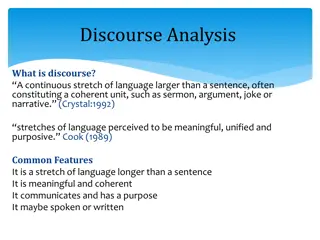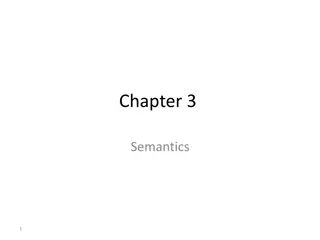Understanding Levels of Meaning in Language
Explore the concept of denotation versus connotation and delve into the various types of connotative meanings including attitudinal, associative, affective, and allusive meanings presented by Ayat Amer AbdI.-Sattar. Discover how words can carry multiple layers of meaning beyond their literal interpretation.
Download Presentation

Please find below an Image/Link to download the presentation.
The content on the website is provided AS IS for your information and personal use only. It may not be sold, licensed, or shared on other websites without obtaining consent from the author. Download presentation by click this link. If you encounter any issues during the download, it is possible that the publisher has removed the file from their server.
E N D
Presentation Transcript
Levels of Meaning Presented by : Ayat Amer Abdl -Sattar
Denotation versus connotation Any sign can produce two kinds of meaning: denotative and connotative. The denotative meaning is the literal (direct) meaning that can be understood via a direct and clear relationship between the sign and the thing it refers to. The connotative meaning is that meaning which comes into existence as a result of an interaction between the sign and the user s context.
For example: Denotative meaning: Nasirriyya is a city in the south of Iraq. meaning: It refers to wicked people or Connotative sometimes to a wicked sense of humour. Denotative meaning: It is from the verb to sing; they say: he is singing. Connotative meaning: To exaggerate.
Connotation: Different overtones Connotation refers to the personal aspects of meaning, the emotional associations that the word arouses . There are six types of connotative meaning as follows:
Attitudinal meaning: It refers to the attitude that the language user has according to his/her socio-cultural experiences. For example: ) (
Associative meaning Associative meaning is that part of meaning that has to do with the stereotypical images that have been conjured up in the mind of the language user towards the lexical items used. When Arab interpreters/translators hear/read the English word secretary, they automatically associate it with the idea of female gender, thus rendering it into ( i.e., female secretary).
Affective meaning Affective meaning refers to that part of meaning that reflects the choice of lexical items resorted to by the language user and their effect on the addressee. . I don t want to see your face in the office. . Go out of the office. If you don t mind, is it possible to leave the office?
Allusive meaning Allusive meaning is that part of meaning that is attached to a referring expression in addition to its denotative meaning by virtue of intertextuality. the following example quoted from Mahfouz s novel (The Beginning and the End) may be considered here: . Here, the writer opts for building intertextual relation with a Quranic verse .
Collocative meaning Collocative meaning Collocative meaning is that part of meaning that is attached to a referring expression in addition to its denotative meaning by virtue of the meaning of other words that collocate well with it, thus forming commonly used expressions. For example: . Day and night. Black and white
Reflected meaning Reflected meaning is that part of meaning that is attached to a referring expression in a certain context in addition, of course, to its basic, straightforward meaning. Consider, for instance, the word in Arabic. The word meaning that refers to an animal like a small horse with long ears in the real world and it is used to describe people s stupidity in the Arab culture. in addition to its denotative ,
Stylistic meaning Stylistic meaning is that part of meaning that distinguishes referring expressions from one another in terms of their degree of formality, their literary status, their degree of politeness and euphemism, and so on. All of them share the same core denotative meaning of to fail. They differ in their stylistic meaning (connotation). informal, and having no literary status. standard, formal, and neutral. standard, formal, neutral, and having literary status. : standard, formal, and having both literary status and euphemism.
semiotics The most common definition of semiotics is that it is the study of Signs. Or it is the study of signs, signification and signifying systems. The subject of semiotics is divided into three main areas: the sign itself, that is, the study of signs and their different varieties in different contexts. the codes into which signs are constructed and organized. the culture within which these codes and signs operate.
Paradigmatic and syntagmatic axes According to de Saussure, there are two ways in which signs are organized into codes( axes) : syntagmatic and paradigmatic. The vertical axis is paradigmatic and the horizontal one is syntagmatic. Paradigmatic and syntagmatic axes paradigms focus on the selection of some signs and the exclusion of others. syntagms focus on the combination of the selected signs.
St: Muslim women wear the head-covering (hijab) in fulfilment of God s decree to dress modestly. TT: . As stated above, a paradigm is a set of signs from which the one used is chosen. To elaborate, in the original text, the sign wear in simple aspect is chosen from a set of possible signs, such as can wear, must wear, should wear, need to wear, and so on.
A syntagm, on the other hand, is the linear arrangement into which the signs, which are chosen from paradigms, are combined. Muslim women wear the head-covering (hijab) in fulfilment of God s decree to dress modestly Are combined to formulate the syntagm: Muslim women wear the head-covering (hijab) in fulfilment of God s decree to dress modestly. Any change in these two axes will undoubtedly create a different mental image.

























